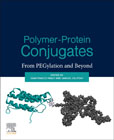
Polymer-Protein Conjugates: From Pegylation And Beyond
Pasut, Gianfranco
Zalipsky, Samuel
Polymer conjugation has already demonstrated its value in improving the clinical outcomes of several proteins by changing their pharmacological behaviour. Homogeneity of conjugates and their purity are one of the most difficult challenges for researchers in this field, also in relation to the requirements of authorization agencies. In this regards the know-how on polymers toxicity on long-term use and how to deal with the risk of immunogenicity require a thoroughly discussion based on real data from the clinical uses of approved conjugates. These discussions will help the researchers to design their new projects also taking into account the latest innovations in the field for a safe and site selective polymer conjugation to proteins. PEG has been so far the gold standard and likely will play this role for other many years but alternatives are coming into the market and some of them have already been launched. Consequently a direct comparison among similar but competitive approaches will help to better shape the future of protein delivery. Now this technique, after 5 decades of improvements, is entering into a new era of innovation thanks the advance in genetic engineering, biochemistry and a better understanding of the results from clinical use of PEG conjugates in humans. All these changes and results, together with future directions are included in this book. Polymer -Protein conjugates is of interest to graduate students working at the interface of chemistry, biochemical engineering/Biotechnology protein chemistry, biology an pharmacology. Many researchers and decision makers in this area, from Universities and Companies, are interested in this book. The book helps the researchers by offering a unique reference and guide into this fascinating area. Overview of the state of the art of protein polymer conjugationProvides the pros and cons of polymer-protein conjugates from the point of view of their clinical outcomesOutlines advantages and potential risks of present technology based on PEGOffers new alternatives for PEG andnew approaches for on site-selective protein modification, ie enzymatic approach of polymer conjugation to proteinIdentifies future direction of research in this field INDICE: 1. Evolution of polymer conjugation to proteins from the early studies 2. PEG and new polymers for protein conjugation 3. PEG antibodies: what the clinical data are really teaching 4. PEG body accumulation and clearance: what is the real risk? 5. Polysialic acid, a polysaccharide that parallels PEG: polysialylation 6. New PEGs: how to use the PEG advantages avoiding its limits 7. Overview of the clinical outcomes of the PEG-protein conjugates 8. The development of Oncaspar biosimilar: difficulties with highly PEGylated protein conjugates 9. PEGylation of blood cofactors: beyond reducing renal clearance 10. The role of PEG for the preparation of next generation of ADC 11. Purification of polymer protein conjugates 12. New methods of production of protein-polymer conjugates 13. Enzymatic approach of polymer conjugation: how to change the approach of conjugate design 14. Genetic code expansion approach for the generation of precise and homogeneous polymer protein conjugates 15. XTEN and PASylation: alternatives to PEGylation 16. Conclusions and future directions of polymer-protein conjugation
- ISBN: 978-0-444-64081-9
- Editorial: Elsevier
- Encuadernacion: Rústica
- Páginas: 312
- Fecha Publicación: 01/11/2019
- Nº Volúmenes: 1
- Idioma: Inglés
